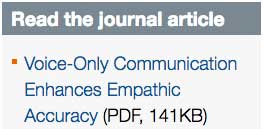October 10th, 2017
 WASHINGTON — If you want to know how someone is feeling, it might be better to close your eyes and use your ears: People tend to read others’ emotions more accurately when they listen and don’t look, according to research published by the American Psychological Association.
WASHINGTON — If you want to know how someone is feeling, it might be better to close your eyes and use your ears: People tend to read others’ emotions more accurately when they listen and don’t look, according to research published by the American Psychological Association.“Social and biological sciences over the years have demonstrated the profound desire of individuals to connect with others and the array of skills people possess to discern emotions or intentions. But, in the presence of both will and skill, people often inaccurately perceive others’ emotions,” said author Michael Kraus, PhD, of Yale University. “Our research suggests that relying on a combination of vocal and facial cues, or solely facial cues, may not be the best strategy for accurately recognizing emotions or intentions of others.”
In the study, which was published in APA’s flagship journal, American Psychologist®, Kraus describes a series of five experiments involving more than 1,800 participants from the United States. In each experiment, individuals were asked either to interact with another person or were presented with an interaction between two others. In some cases, participants were only able to listen and not look; in others, they were able to look but not listen; and some participants were allowed to both look and listen. In one case, participants listened to a computerized voice reading a transcript of an interaction — a condition without the usual emotional inflection of human communication.
CONTINUE READING…APA – Recognising Emotions in Others: Study
Share This Post:







Leave a Reply